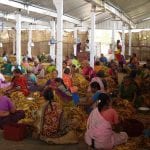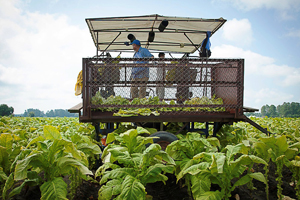Even as overall leaf supply and demand inches toward equilibrium, flavor styles are getting scarce.
By Stefanie Rossel
After two years of global oversupply, a more balanced leaf tobacco market is slowly coming into sight. “We recognize that there has been a global oversupply of flue-cured Virginia over the past few years, with the burley supply more in balance,” says Graham Kayes, executive vice president for business relationship management and leaf at Alliance One International. “However, in the upcoming crop, we expect to see adjustments in crop sizes, particularly in areas affected by El Nino.”
The surplus was due to a combination of factors, according to Iqbal Lambat, CEO of Star Tobacco International, which is headquartered in Istanbul. While there were larger-than-anticipated crops in major leaf-producing countries, such as Brazil, Zimbabwe and India, all major cigarette manufacturers had decided to cut their inventory holding levels by as much as 12 months, which meant that they purchased an absolute minimum.
Simpler blend structures, cheaper leaf and—where allowed—greater use of artificial flavorings also played a role, according to Star Tobacco. “The increasing utilization of leaf derivatives such as dry ice expanded tobacco, cut-rolled expanded stems and reconstituted leaf in the final blend has led to a sharp decrease in the sales of traditional tobacco leaf lamina,” says Lambat. The vertical integration of leaf operations into cigarette manufacturers’ operations impacted the sales of independent leaf merchants, as well.
Lambat cites the example of Japan Tobacco, which in 2010 began to acquire leaf dealers and growers on a worldwide basis, thus gaining direct control over more than 40 percent of its leaf requirements.
The 2015–2016 crop will be significantly smaller than the previous one. Universal Leaf, the world’s largest leaf merchant, estimates that across all tobacco types, global (green) leaf production shrank to 5.85 billion kg in 2015 from 6.3 billion kg in the previous year (also see chart).
The 2015 U.S. flue-cured crop was about 40.82 million kg (90 million pounds) smaller than the 2014 crop (which was a large one), according to Blake Brown, Extension economist at North Carolina State University. “Despite these reductions, U.S. inventories of U.S flue-cured tobacco in January 2016 were still 679 million pounds according to the [U.S. Department of Agriculture] Agricultural Marketing Service, and almost 200 million pounds greater than in January 2015.”
Global inventories of flue-cured tobacco were very high going into 2015, according to Brown. “The lack of reduction in U.S. inventories may indicate that lower global production of flavor-style flue-cured may be resulting in lowering of flue-cured inventories elsewhere in the world. For U.S. producers this is reflected in lower contracted quantities.”
Altogether, Star Tobacco estimates, global leaf supply will shrink by between 470 million and 500 million kg in the 2015–2016 season, which represents a 12 percent decline and points to an equilibrium of supply and demand in mid-2017 at the earliest.
Kayes expects FCV to be entering a time of short supply while the accelerated decline of cigarette sales has bottomed out. “There will therefore need to be future adjustments to the [FCV] crop size,” he says. “We expect demand for burley to remain fairly balanced for the next few years.”
Adverse weather

Getting the balance right in global tobacco leaf supply, however, remains a complex exercise—while the overall crop still exceeds demand, there is undersupply for specific origins and grades, Lambat points out. “Brazil high-nicotine burley 2015–2016, for example, is already sold out, and demand has not been satisfied at this early stage of the sales season.”
Together with Zimbabwe and the U.S., Brazil is a leading supplier of flavor tobacco. During the 2015–2016 crop season, the country suffered from prolonged rains caused by El Nino, whereas Zimbabwe experienced a severe drought. As a result, aromatic tobacco stocks are running low, notes Rainer Busch, general director of NewCo, which is headquartered in Singapore. “If the weather conditions recur in the coming crop, the manufacturers will be in trouble,” he says.
While Brazil’s tobacco quality remains good, El Nino has had a dramatic effect on the country’s volumes. According to Lambat, Brazil had already decided to reduce FCV production from 650 million kg in 2014–2015 to 500 million kg in 2015–2016. “Due to El Nino, FCV production is closer to 440,000 tons and burley is one of the shortest crops on record, at slightly less than 50,000 tons—half the normal output level,” he says.
Around 200,000 farmers in Brazil grow tobacco, mainly in the provinces of Parana, Santa Catarina and Rio Grande do Sul. At an average of $3.40 per kilogram, the prices they receive rank second only behind those in the U.S., according to Star Tobacco. However, the company expects Brazilian leaf prices to decline due to the country’s weakening currency.
There may, however, also be a positive side to this development, as Brown indicates. “The dramatic devaluation of the Brazilian real provides both opportunities and challenges for Brazilian tobacco producers,” he says. “Exports of Brazilian products are much more competitively priced in the global market, especially relative to U.S. products.” On the other hand, imports into Brazil are more expensive. Brazil imports a lot of its fertilizer, so production costs have increased.
“Even so, more competitively priced tobacco from Brazil gives global leaf merchants an incentive to increase production there,” says Brown. “Even though tobacco product manufacturers are careful about changing blends, there seems to be enough leeway so that, historically, exchange rates have had substantial impacts on where leaf is produced. In the absence of some supply shock like bad weather, exchange rates will cause U.S. production to remain low, with production shifting toward Brazil.”
El Nino also had an adverse effect on Africa, according to Kayes, but with variations among individual sourcing areas. “Some markets are starting later, and it is too early to know what sort of impact the dry weather has had on quality. Latest estimates indicated that the drought in Zimbabwe has not had as much of an impact on volume as initially expected.”
Each season, Zimbabwe produces two tobacco crops—an irrigated crop and a rain-fed crop, explains Baldev Mistry, vice president for the African region at Star Tobacco International. “The latter suffered from severe droughts that affected the late crop cycle, pre-harvesting. The latest crop assessment points to 170,000 tons for the current season, down 40,000 tons from the prior season. However, industry insiders place the expected final output to be below 150,000 tons.”
According to Star Tobacco, Africa has the potential to surpass Brazil in terms of FCV and burley volumes. However, the continent’s leaf-growing sector suffers from four challenges: Only 9 percent of Africa’s arable land is irrigated, the level of mechanization is low, crop cash is insufficient, and agricultural practices are poor due to lack of training.
Zimbabwe is a special case, having the potential to produce up to 250 million kg annually. But while the country in the past produced some of the world’s finest FCV, a controversial land reform program has caused quality to plummet. Instead of the 3,000 commercial farmers that once supplied leaf, there are now more than 100,000 small-scale farmers. “[This] has resulted in a crop that is less uniform as different farmers use their own methodology, thereby negatively impacting the reputation of Zimbabwe FCV,” says Mistry. Quality consistency has become an issue due to the large farmer base, he adds, forcing clients to start purchasing from other African origins.
Lower average leaf prices for the 2014–2015 crop also reduced farmers’ incentive to produce tobacco in the current season. Originally projected at 160 million kg, Zimbabwe’s crop is now expected to be significantly smaller.
At a crossroads
The tobacco industry currently is in a state of transition. For a number of years, global cigarette sales volumes have been declining. At the same time, smokers discovered new forms of nicotine consumption, including electronic nicotine delivery systems, which don’t require the large volumes of leaf tobacco that combustible cigarettes do. Both developments, however, have begun to decelerate.
“I think that in most consumer markets the main reduction in consumption has happened and the world is past the highest drop,” says Busch. “The decline in cigarette sales volumes is not only due to fewer consumers but also due to a change of the smoking products. Roll-your-own tobaccos, e-cigarettes, shisha and other products have become more popular over the last couple of years. The swap to other smokable products seems to be decreasing, and the ongoing acceptance of emancipation in other parts of the world and the continuous growth of the population should balance the decline of cigarette sales very quickly.”
While acknowledging the decline in cigarette sales, Kayes points out that tobacco is still a massive industry.
“The major question is how tobacco farmers can compensate for declining demand via alternative crops in order to maintain their income levels,” says Lambat. “The Framework Convention on Tobacco Control’s push for countries to encourage tobacco farmers to switch to alternative crops has clearly demonstrated that in a majority of countries, there are no viable alternatives.”
In this changing landscape, efficiency has become the buzzword, and this trend can also be seen in blending. “Evolving over the past 10 years or so, companies have looked more rationally at their blends,” says Lambat. “Whereas tobacco blenders prefer to work with as many as 15 grades and origins per blend, the current trend is to remove complexity and reduce the number of grades to as few as possible. A flavor grade, a filler grade and tobacco derivatives—sometimes up to 40 percent of the blend—is now the way to go.”
The future will belong to varieties that are characteristic in one way or another, explains Lambat. Advances in technology allow flavorists to better mask any shortcomings in the tobacco blend, allowing cigarette manufacturers to use cheaper leaf varieties. “This will impact ‘stuck in the middle’ origins that are not differentiated by flavor or cost,” says Lambat. “A perfect example is Indian FCV, which is not a flavor origin and unfortunately over the years has become an expensive filler grade.”
Meanwhile, the world’s largest tobacco consumer, China, is experiencing an economic slowdown. To what extent this will affect its leaf purchases, however, remains unclear. “As China’s smokers have become more affluent, they have started purchasing more premium brands of cigarettes that require more high-quality flavor-style tobacco,” says Brown. As sales of higher-end cigarettes have increased in China, so has the demand for U.S., Brazilian and Zimbabwean FCV. The current question, says Brown, is whether China’s slowdown will decelerate or even reverse the trend toward higher-end cigarettes. “I don’t know the answer but it has very important ramifications for U.S. flue-cured exports to China,” he says.
Meeting demand
So while equilibrium of supply and demand is generally difficult to achieve in a global tobacco leaf market, what are the lessons from the current situation?
“The main challenge in each country is ensuring that the growers are providing what the market requires in terms of crop size, quality and price,” says Kayes. “In the future, there will be increasing pressure on growers to improve efficiency in order to remain profitable and there will be additional emphasis on making sure crops are grown in compliance with environmental and labor standards. Additionally, as volumes have declined, many countries are rationalizing their processing and production capacity to ensure markets remain competitive and viable.”
As manufacturers continue to reduce complexity in their supply chains, Kayes expects further alignment between companies with similar principles, presenting an opportunity for sustainable and compliant leaf suppliers.
AOI directly contracts with more than 300,000 tobacco growers worldwide to provide agronomy services and encourage sustainable, compliant tobacco leaf production. Through the partnerships created by the integrated production system (IPS), growers and suppliers can effectively collaborate to produce tobacco that maximizes return to the grower, minimizes environmental impact, protects the rights of those involved in crop production and meets quality expectations, according to Kayes. “Through the partnerships created in IPS, we can find the right balance between supply and demand,” he says.
Star Tobacco International recently examined the prices paid to farmers, which have traditionally followed a yo-yo pattern. High prices in a given season typically result in a larger crop in the following season, which in turn depresses prices and reduces the incentive for leaf production in the next season. “One of our major conclusions is that farmers are unable to live with an annual contract that guarantees off-take for that particular year only but not thereafter,” says Lambat.
“In a majority of cases, farmers are looking for three- to five-year production and off-take contracts that allow them the financial stability to take up a mortgage, send their children to university, etc. In an industry with a retail value of $800 billion, the tobacco farmer is the most forgotten element in the chain and always on the short end of the stick,” he says.
































